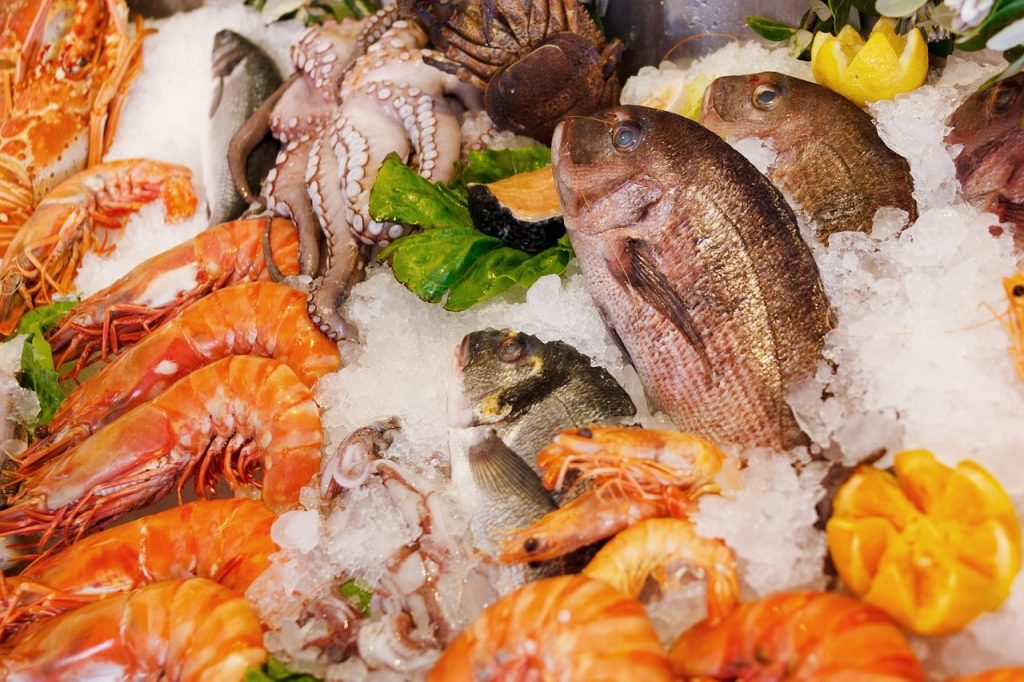
Several studies associate seafood with a higher risk of gout attacks. However, not everything is as it seems. Read on to discover how fish and shellfish can be an integral part of a gout-friendly diet.
Seafood and Gout
First, let’s take a moment to clarify what we mean by seafood…
What is Seafood?
I’ve noticed that some people use the name “seafood” to mean shellfish; so for them “fish” and “seafood” are separate entities.
Here, I use “seafood” to mean both fish and shellfish.
Shellfish includes crustaceans (crabs, shrimps, lobster, etc.), molluscs (clams, mussels, oysters, etc.), and cephalopods — part of the mollusc family — e.g, octopus, cuttlefish, squid, etc.
So seafood means any creature found in the sea that we eat for food.
What is Gout?
Gout is a type of inflammatory arthritis whose root cause is abnormally high levels of uric acid in the blood.
Excess uric acid is normally flushed from the body in urine but if not enough is excreted from the body, or too much is produced in the body, then acid levels can start to creep up.
If this continues unabated uric acid concentrations can reach the saturation threshold, at which point tiny uric acid crystals can accumulate in the joints and surrounding tissue.
The presence of such crystals triggers the body’s natural inflammatory response, which floods the affected joint with inflammatory mediators.
This causes the affected joint to become red, swollen, tender, and hot to the touch: the typical symptoms of gout or, more accurately, a gout attack or flare-up.
These attacks are most common in the big toe, although any joint is susceptible.
Where Does Uric Acid Come From?
Uric acid is the end product of purine metabolism, which purines are natural chemical compounds found in the cells of all living things, including we humans, animals and plants.
Around thirty percent of of the uric acid in our bodies comes from purines in the food we eat — not an inconsiderable amount.
So gout patients are usually advised by their primary care provider to move to a low-purine diet, which entails avoiding or limiting purine-rich foods.
Animal-based foods are generally higher in purines than plant-based foods, so the focus is more on meat and seafood than vegetables, fruit, whole grains, and so on.
Purines in Seafood
Different foods contain different amounts of purine compounds.
For example, some meats, such as organ meats and wild game, have high levels of purines, as do some types of seafood, like anchovies, sardines, herring, mackerel, mussels, and shrimp. These are normally avoided.
However, not all meat and seafood are as high in purines: beef, pork and lamb have moderate levels of purines, as have cod, haddock, salmon, crab, and lobster. These may be consumed in moderation.
And there are many low-purine foods: vegetables, fruit, whole grains, nuts, seeds, low-fat dairy products and even some types of fish and shellfish, such as plaice and crayfish.
As you can see, not all seafood is bad for gout. It’s what type you eat, how much, and how often, that counts. (More on this later.)
So by avoiding or, at the very least, limiting the highest-purine seafoods, and consuming the rest in moderation, you can help to reduce the risk of recurrent gout attacks.
But why eat seafood at all? Why take even the slightest risk with your gout?
Seafood is our main dietary source of omega-3 fatty acids…
Health Benefits of Seafood
Seafood is an excellent source of high-quality protein, is low in both total and saturated fat, and a good source of vitamins A, B6, B12 and D, as well as zinc, copper, selenium, iron, and iodine.
However, the outstanding nutrients in seafood are omega-3 fatty acids, which are essential polyunsaturated fats that we must get from food. Our bodies cannot make these healthy fats for themselves.
Studies show that omega-3 fatty acids may:
- lower the risk of heart disease and stroke
- reduction chronic inflammation
- lower blood pressure
- reduce insulin resistance
- support mental health
- protect against age-related mental decline
- protect joints
Which is why the American Heart Association and many international health bodies recommend eating fish at least twice a week.
It’s also recommend that one of these meals should be cold water fatty fish — also called oily fish — which contain more omega-3 fatty acids than white fish.
Fatty fish are species such as herring, sardines, pilchards, anchovies, salmon, trout, and mackerel.
White fish includes the likes of cod, haddock, hake, halibut, flounder, sole, sea bream, and sea bass.
Omega-3 fatty acids are also found in shellfish — particularly mussels, oysters, crab, and squid — albeit at lower levels than fatty fish.
But there are real concerns over toxins in fish and shellfish…
Toxins in Seafood
One of the reasons why experts advocate restricting seafood to twice weekly is because of concerns over pollutants and toxins in some types of fish and shellfish.
For example, bottom feeders, like cod, halibut and flounder, are prone to man-made toxins, such as PCBs (polychlorinated biphenyls).
And fish at the top of the food chain, such as swordfish, shark, tuna, and king mackerel, are also notorious for having high mercury levels.
But there are natural toxins too. These “phycotoxins” are produced by certain types of algae.
Phycotoxins tend to accumulate more in coral reef fish and shellfish. For example, in some types of grouper, wrasse and snapper, as well as in mussels, clams, scallops, oysters, and crabs.
And, of course, microplastics are increasingly being discovered in fish.
So restricting carefully selected seafood to twice a week may strike a reasonable balance between their undoubted health benefits and the risk of too many toxins building up in your body.
And, as far as gout is concerned, twice weekly also helps to balance those wider health benefits and any potential gout risk due to their purine content.
In Conclusion
Seafood is the main dietary source of omega-3 fatty acids that are associated with a reduced risk of several chronic diseases, including cardiovascular disease.
However, some types of fish and shellfish are prone to toxins.
Fortunately, these risks can be ameliorated by selecting only the least risky fish and shellfish and restricting their consumption to a maximum of twice weekly.
But gout sufferers also have to concern themselves with the purine content of different types of seafood…
Gout sufferers should avoid or severely limit high-purine seafood, such as anchovies, sardines, shrimp, clams, trout, tuna, prawns, herring, halibut, and mackerel.
Moderate-purine white fish, such as cod, haddock, hake and plaice, should be limited to 1 x 3.5 ounce serving once per week.
A similar serving of moderate-purine fatty fish, such as salmon, sea bass, and sea bream, may be consumed once a week as well.
In other words, limit your overall seafood intake to two moderate (3.5 ounce) servings a week, one of which should be fatty fish.
And ensure you buy only top quality, ethically-sourced, sustainable fish and shellfish from respected purveyors.
Finally, remember that grilled, baked or steamed seafood is a much healthier option than fried seafood.



